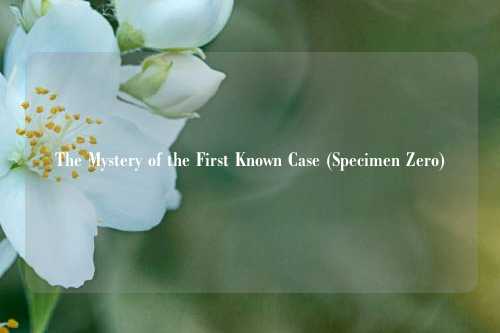The Mystery of the First Known Case (Specimen Zero)
The term "specimen zero," also known as "patient zero," has long held a morbid fascination in the realm of epidemiology and public - health research. It represents the individual who is believed to be the first case of a particular infectious disease in an outbreak, and unraveling the identity and circumstances of specimen zero is often a crucial step in understanding and controlling the spread of a pathogen.
In the history of disease outbreaks, identifying specimen zero has been a complex and sometimes controversial task. Take, for example, the HIV/AIDS epidemic. For many years, a French - Canadian flight attendant named Gaëtan Dugas was wrongly labeled as patient zero. In the 1980s, researchers used him as a reference point in their early mapping of the spread of the disease in the United States. However, later genetic studies have shown that HIV had been present in the United States and other parts of the world long before Dugas became symptomatic. This misattribution not only caused great personal distress to Dugas and his family but also highlighted the difficulties in accurately pinpointing the first case of a disease, especially when dealing with a pathogen that has a long incubation period and may go undetected for a while.

The significance of finding specimen zero is multi - fold. First and foremost, it can provide valuable insights into the origin of the disease. By studying the individual's lifestyle, travel history, and contacts, epidemiologists can trace back the possible source of the pathogen. For an emerging infectious disease like Ebola, which is often zoonotic (transmitted from animals to humans), understanding where and how the first human infection occurred can help prevent future outbreaks. If specimen zero was exposed to a particular species of wild animals in a specific geographical area, conservation and public - health measures can be targeted at that location to reduce the risk of further spill - over events.
Secondly, identifying specimen zero can assist in mapping the transmission routes of the disease. Once the first case is known, investigators can start to build a chain of transmission, connecting subsequent cases to the initial one. This helps in understanding how the disease spreads from person to person, whether it is through direct contact, respiratory droplets, or contaminated food and water. Such knowledge is essential for implementing effective control measures, such as isolation of infected individuals, contact tracing, and the promotion of proper hygiene practices.
However, there are numerous challenges in the search for specimen zero. In many cases, the early symptoms of a disease may be mild and non - specific, leading the individual to ignore them or attribute them to other common ailments. By the time the disease is recognized as a significant public - health threat, the first case may have already passed away or recovered, leaving few clues for researchers. Additionally, in a globalized world where people travel frequently, it can be extremely difficult to determine where the infection actually started. A person may become infected in one country but only show symptoms after arriving in another, creating a false trail for investigators.
In conclusion, the concept of specimen zero is both a powerful tool and a complex enigma in the fight against infectious diseases. While it offers a starting point for understanding the origin and spread of an outbreak, the process of identifying the first case is fraught with difficulties and uncertainties. As our world becomes more interconnected and new pathogens continue to emerge, the search for specimen zero will remain a critical but challenging aspect of public - health research. We must approach this task with caution, relying on a combination of scientific evidence, advanced technology, and ethical considerations to avoid the mistakes of the past and effectively combat the next global health threat.
版权声明
本文仅代表作者观点,不代表xx立场。
本文系作者授权xx发表,未经许可,不得转载。
 百捷网
百捷网



